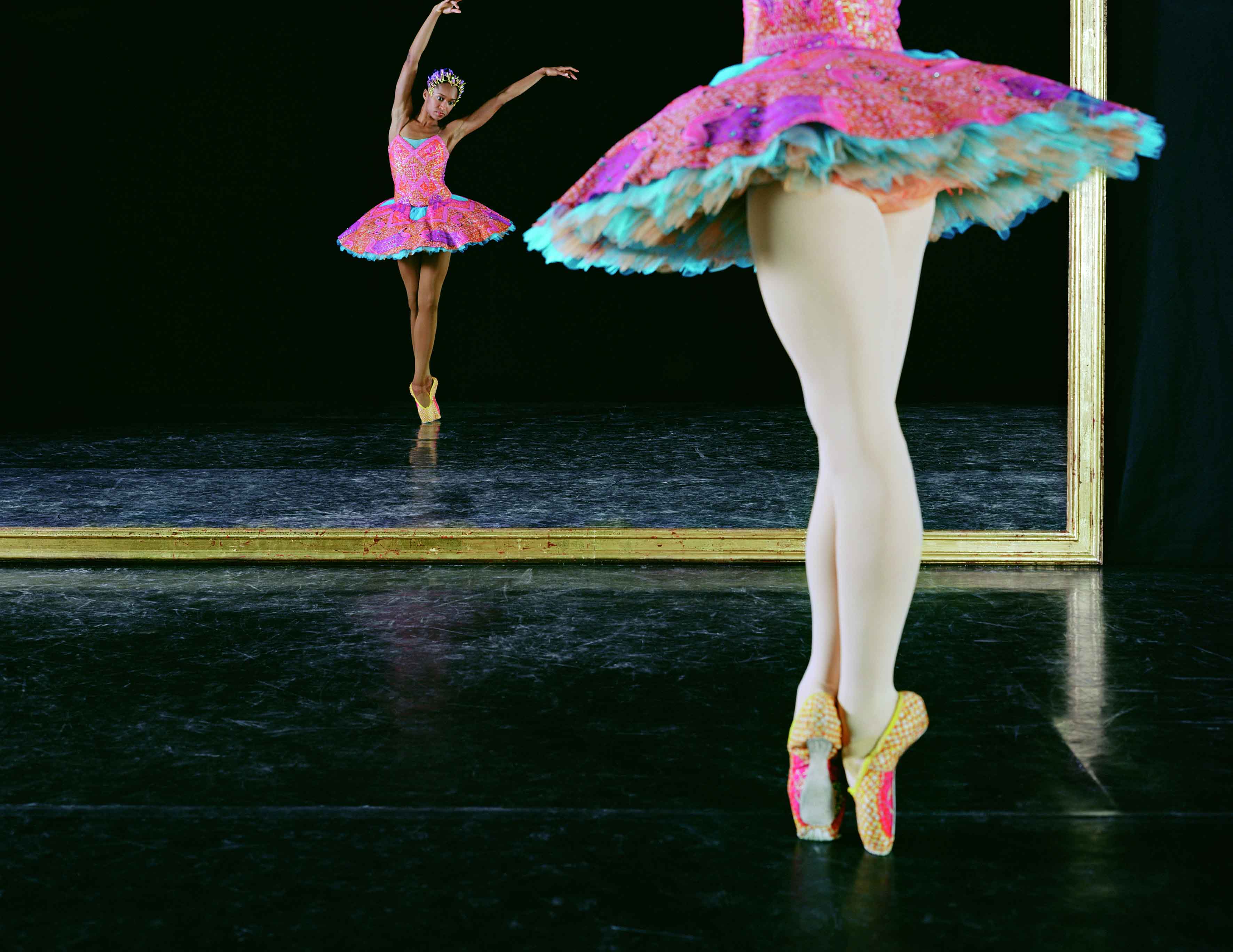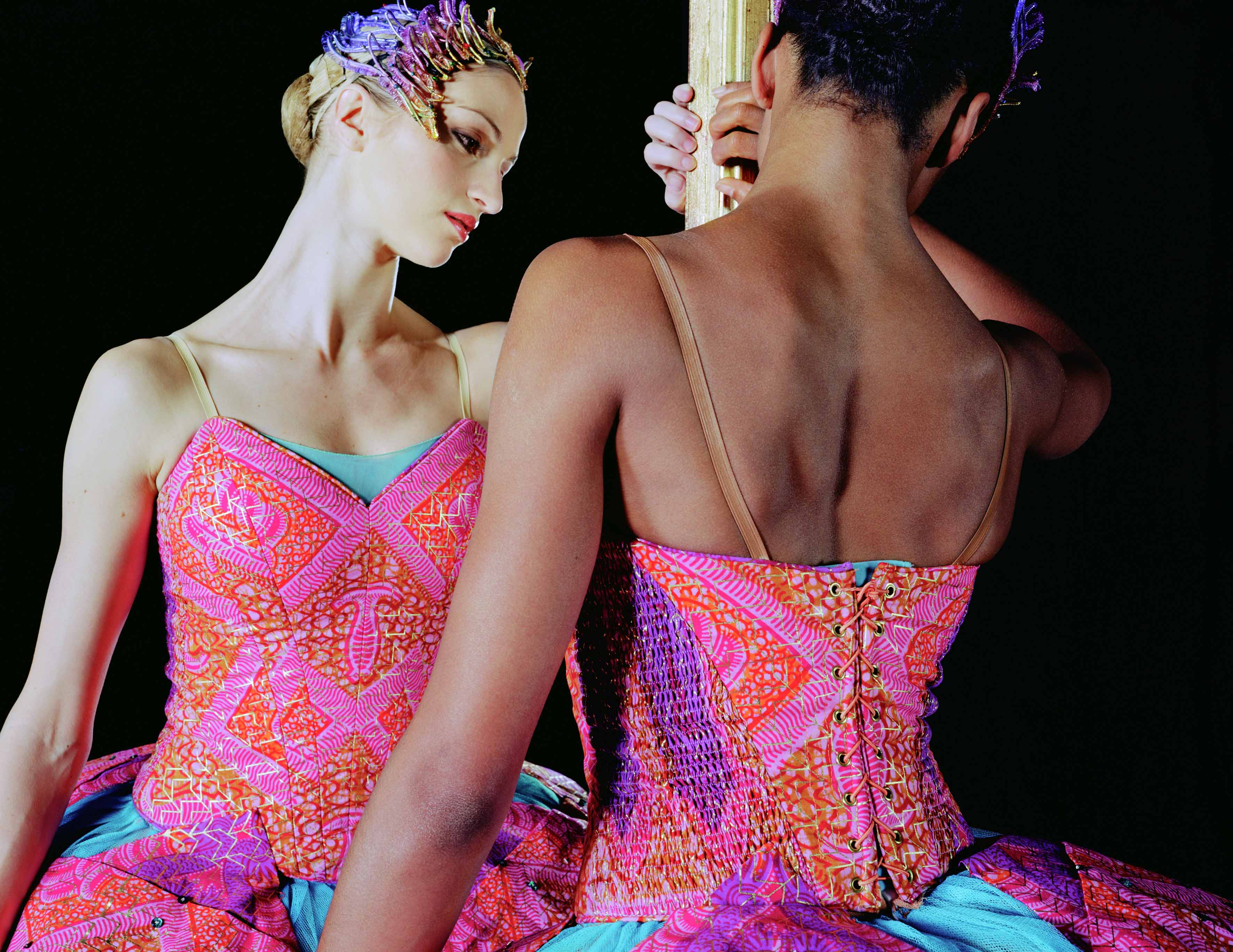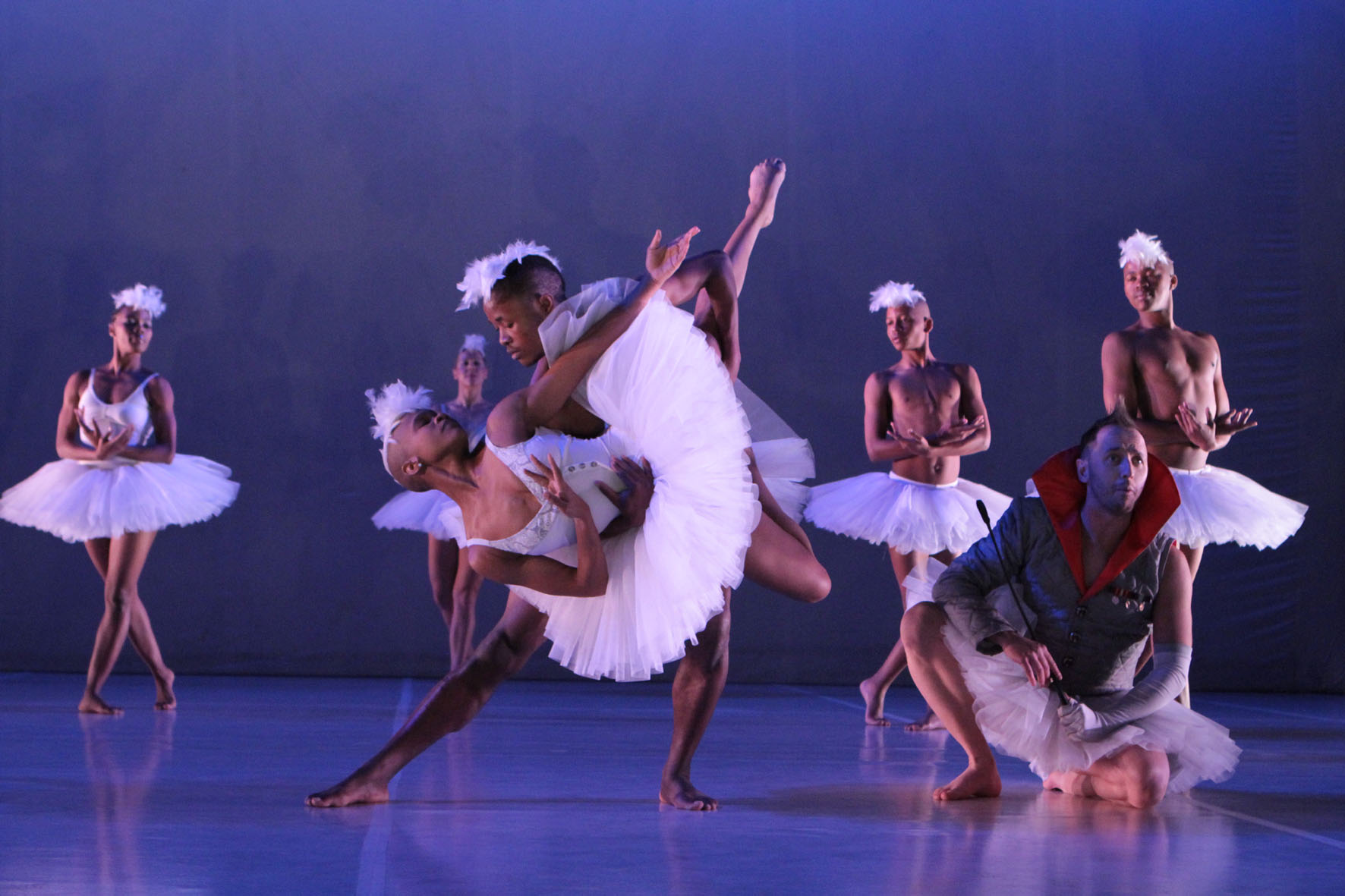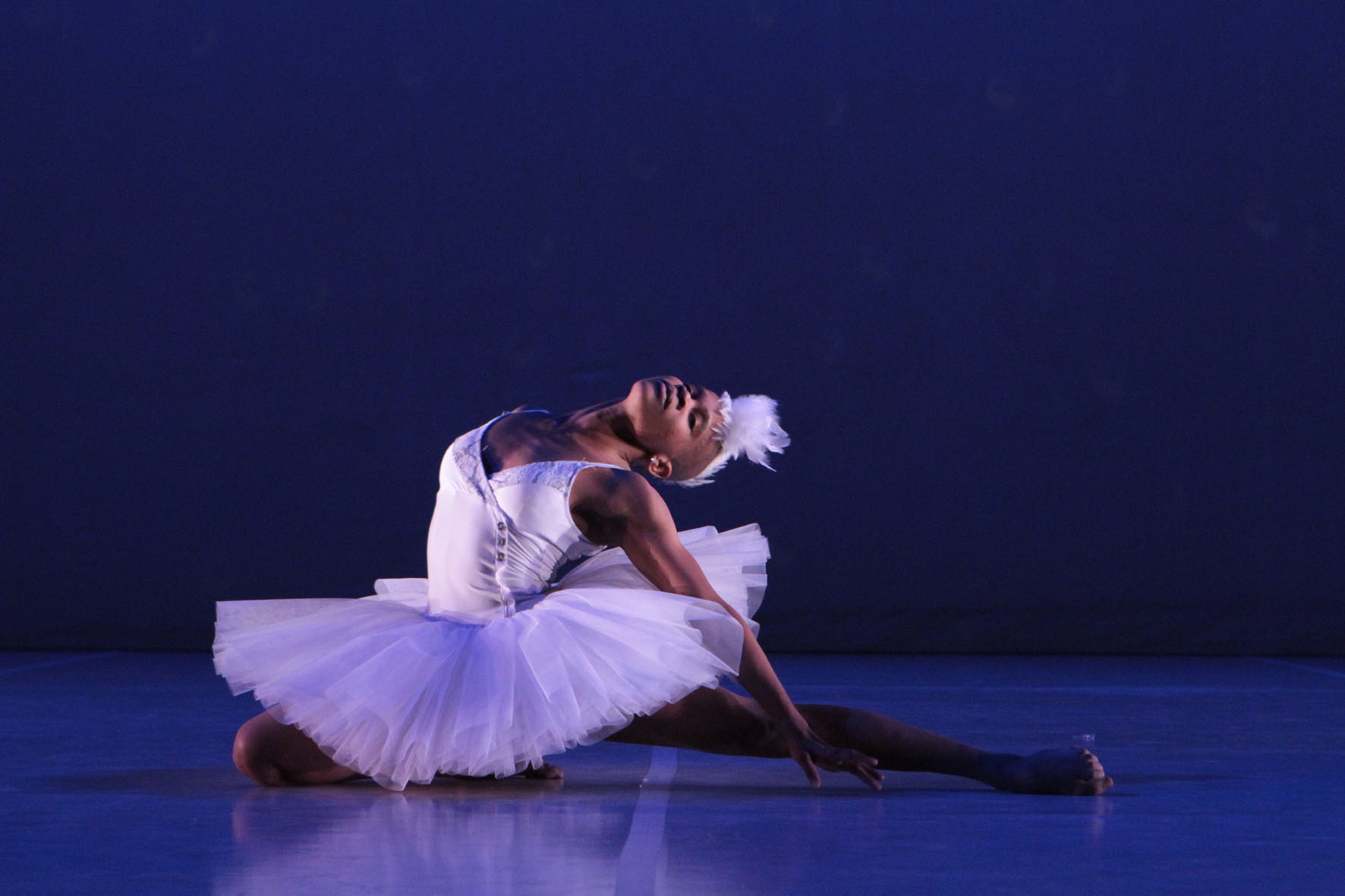May 15, 2013
Dada Masilo – Yinka Shonibare:
Upending the Classics
Written by Julie Crenn
Since the 1980s and 90s, a great many artists hailing from Africa and the Diaspora have been focusing and reflecting on the theme of the black body: its iconography, the various devices for its portrayal and the different perspectives adopted – a collective reflection that finds its roots in the early 20th century, notably among the protagonists of the Harlem Renaissance. The latter wished to highlight a black culture that had hitherto been repressed, gone unrecognized and been deemed undesirable. This gesture of affirmation and resistance was in turn taken up by activists, writers and artists of the 1960s and 70s, in a deeply politicized movement proclaiming the need to assert the identity, the history and the contemporary realities of people of African descent. From the engagement that ensued, a prolific era of artistic and literary creation was born, foregrounding a black voice muffled, before then – if not altogether strangled – by white society. Such is the recent heritage on which artists of the postcolonial era have built in their quest to expand upon and to move beyond the issues first raised in the 1920s and 1930s.
One such issue endures and provides critical matter for these artists: the blatant lack of models for black representation in a global society that remains dominated by the white imago. In the face of such an enduring, uniform system of reference, new models and codes are required. Developing these lies at the core of the work of such artists as Renée Cox, Tracey Rose, Kehinde Wiley, Yinka Shonibare, Hassan Musa, Dada Masilo, Mary Sibandé and Zanele Muholi, to cite but a few examples. Working in a wide range of genres, these creators strive to multiply, integrate, distort and deconstruct a collective imagery based at its heart (and despite multiple claims to the contrary) on the primacy of the white body. To this end, both as a means of indexing absence and to restore some manner of balance, they divert and translate the “classics” in such media as painting, sculpture, literature, ballet or opera. By this means they revisit a univocal iconography and a truncated history bolstered by hackneyed theories.
In order to apprehend the scope of this aesthetic, theoretical and critical movement, I offer a reading, here, of a double translation: takes by two different artists on a major work of European ballet, Swan Lake. The artists are Yinka Shonibare (born 1962 in Great Britain), whose video installation Odile and Odette (2005) draws my attention, and Dada Masilo (born 1985 in South Africa), on whose 2012 Swan Lake I focus. My goal is to reflect on ways in which the two artists have succeeded in distilling their engaged discourses by inserting the black imago into a context from which it had been historically and culturally excluded, while infusing it with a distinct social, political and gendered charge.
A brief historical reminder: Swan Lake is a four-act ballet, composed in 1876 by Piotr Illitch Tchaïkovski (1840-1893). It dramatizes the story of Prince Siegfried who, upon coming of age, is urged by his parents to find a bride. Siegfried, however, has no wish to submit to an arranged marriage. During an evening party, he leaves his parents’ castle and sets out on a night hunt, in the course of which he encounters a flock of swans. As he is about to kill one of them, it morphs into a woman, Odette. Siegfried is beguiled by the swan-woman, a princess sentenced by the wizard Rothbart to exist in the shape of a swan by day and to return to her womanly form at night. A vow of eternal love alone is liable to break the spell. Siegfried pledges such a love and bids her appear on the morrow at the ball held by his parents. Daylight dawns, Odette turns once more into a swan and is unable to acknowledge the invitation. During the ball, the young prince meets a second woman, Odile, a perfect likeness of the swan-woman, but for one detail: she is dressed in black. Siegfried is blinded by the likeness and pledges his love to Odile, thus dooming Odette to a lifetime of constant metamorphosis. Once aware of the deception, he sets out in search of Odette. Several final versions have been suggested: the lovers die and are resurrected; the wizard is unmasked and executed; the swan vanishes and the prince dies of grief. This, in a nutshell, is the outline of the ballet that Shonibare and Masilo revisit, seeking to think it in terms and in forms more relevant to our manifold and complex 21st century world.
Hybridizing the Classics / Yinka Shonibare
Striving to be both European and black requires some specific forms of double consciousness. By saying this I do not mean to suggest that taking on either or both of these unfinished identities necessarily exhausts the subjective resources of any particular individual. However, where racist, nationalist, or ethnically absolutist discourses orchestrate political relationships so that these identities appear to be mutually exclusive, occupying the space between them or trying to demonstrate their continuity has been viewed as a provocative and even oppositional act of political insubordination.[1]
Since the 1990s, Yinka Shonibare has been a key figure of contemporary art, not only in Great Britain but internationally as well. His practice is multi-faceted: painting, installation, photography, and video. He develops a counter-vision of history as written and taught in the West, thus presenting the public with a transgressive reinterpretation and reshuffling of ruling ideologies. His goal is to prompt a different way of thinking, not by formulating a systematic and scientific revision of history, but rather by selecting and in the process casting a new spin on works, objects and events that are both heavily loaded with symbolism and related to a precise era. Seizing on British colonial history and the history of European art, he eludes and diverts the codes of representation and the stereotyped discourse linked to cultural identities. He has more particularly elected to focus on the Victorian era and British colonial expansion of the 18th and 19th centuries, with a view to exploring his hybrid identity, both British and Nigerian (he grew up in Lagos, then settled in London with his parents). Irony, parody, whimsy, aestheticism and poetry are his weapons of criticism: cultural weapons that he deploys to access strong, disturbing, unsettling topics, all in link with his commitment to an engaged (re)presentation of the black body.

Odile and Odette, the 2005 video piece on which I focus here, was the outcome of a project linking two London institutions, the Africa Centre and the Royal Opera House, in the context of an event titled Africa 05.[2] The artist explains: “I thought that would be a great opportunity to look at the relationship between the Royal Opera House and the Africa Centre, both institutions representing a colonial relationship and a cultural relationship”.[3] In this setting, Shonibare appropriated Tchaïkovski’s ballet in order to propose a personal re-reading of it. “I tried to go beyond what would be expected of somebody of African origin and I thought: I’ve never done a ballet, so why not? No one ever questioned Picasso’s interest in and use of African art, but Africans are always expected to just do “African” things. In the contemporary world where we all travel, that’s just not realistic. I see opera like everybody else, and I see popular culture like everybody else. I always like to work with iconic things, and Swan Lake is very well known, probably the most popular ballet”.[4] With this as his staring point, he chose to centre his film on the bodies and motions of the rival ballerinas. Traditionally, a single ballerina embodies both key characters, Odile and Odette; the version imagined by Shonibare, however, features two ballerinas, one white and the other black. Traditionally, costume colour – a white and a black tutu – differentiates the two women. Here, the difference is one of skin hue. Shonibare maintains the duality between black and white by pointing to the racial connotations of the colours’ symbolism.
Odile and Odette face each other, gracefully creating a perfect mirror effect.[5] In a symmetrical and mimetic way, they perform the same choreography and are visually separated by a non-existent mirror, of which all that remains is the heavy, baroque-style frame. They play the part of Odette, a girl doomed to exist in the shape of a swan and to regain the body of a woman only at nightfall; and Odile, the usurping daughter of the wizard Rothbart, the instigator of the spell cast upon Odette: “Thou shalt be swan by day and woman at night. Thou shalt thus live till the charm be broken by wedlock”. In most performances of Swan Lake, the character of Odile is dressed in black, while Odette wears a white costume symbolically reminiscent of the swan’s features. The chromatic opposition thus confers a Manichean perspective to the tale. The artist says: “The roles – one as the ego and one as alter – in my version are more ambiguous: you would not necessarily be able to tell who is the bad one and who is the good one”.[6] Because they seem to reflect each other, the two women merge.

Both dancers wear pointe shoes and tutus made of Dutch wax cloth. In the West and in the East alike, cloth of this kind is commonly held to be “authentically” African. Here as in other works, Shonibare makes use of it for its aesthetic qualities, as well as for its symbolic and historical heft. The latter two are cornerstones of the artist’s thought and practice. To make sense of this, some manner of background is necessary. The type of cloth in question was first developed in the 19th century, as a result of Dutch merchants’ wish to flood the Indonesian textile market with cheap knock-offs. The idea was to use mechanical means to make mass-produced batiks that would replace the hand-crafted originals. These would then be marketed to Indonesian clients, who, it was expected, would become the primary consumers of this new, ersatz genre. The operation was a total failure: the machines were unable to replicate the handiwork of the weavers, resulting in inconsistent and inexact patterns that proved wholly unacceptable to Indonesian users. By century’s end, it was clear that an alternative market would need to be found to sell off the accumulated stocks of industrial batiks. The destination chosen was West Africa. Colours and patterns were transformed and adapted to suit local tastes. The fabrics were printed with identity symbols, sayings and quotations extolling the values and aspirations of the African Gold Coast. The West African market was immediately won over. Dutch wax cloth proved a roaring success, as people appropriated it for their own cultural uses and, ultimately, transformed it into a Pan-African symbol. “The textiles [Joan Gibbons writes] are the products of Western economic expansionism and are cultural appropriations, and as such they carry associations of exploitation that go with the era of Western imperialism and colonialism in which they were produced”.[7] Shonibare adds that they are “a metaphor of the complexity of hybridized identities”.[8]
And this, of course, is the heart of the matter. In the classical version of the ballet, the colour of the costumes helped the audience to differentiate between the two young women. Here, the tutus are made out of the same multi-coloured fabric and so it is to the dancers’ skin colour that the public is forced to look. But, in the end, this does little to assist in differentiating the one from the other, for, as we have seen, they are overlapping parts of a single, hybrid whole: the persona of the artist himself. From this stems the subversive force of the piece.
Key as well to its force is the focus it places on confrontation. The tête à tête around which it is structured demands of the viewer that s/he face head-on the systemic elision of black bodies in opera, ballet and contemporary artistic production more generally. Too, it questions stereotyped dichotomies that prevail between the “fine” arts and African art, as these are perceived and defined by Western critics. This questioning, in turn, is compounded by a criticism of uses to which art is put to bolster social distinctions – a criticism arguably implicit in the manner in which the piece was displayed. Odile and Odette was screened outdoors in the summer of 2005 in London. In parks and places like Trafalgar Square it was made accessible for free, on giant screens. Perceived by many – and with good reason – as profoundly elitist forms of cultural expression, ballet and contemporary art alike found themselves actively deterritorialized. In the process, long-standing dichotomies fell by the wayside.
Deconstructing the Ballet / Dada Masilo
South-African dancer and choreographer Dada Masilo similarly commits herself to erasing dichotomous relationships that underlie the history of arts and cultures as these tend to be conceptualised in the West. To this end, she calls up and melds theoretically distinct levels of reading and repertoires: popular / elitist, classical / modern, traditional / contemporary, masculine / feminine.

After revisiting such classics as Death and the Maiden (Ariel Dorfman), Romeo and Juliet (William Shakespeare) or Carmen (Georges Bizet), Masilo seized on Swan Lake to confront South African genres, traditions and social realities.[9] Born in Johannesburg, she grew up in Soweto, where she very early took up dancing. At the young age of eleven, she was already a member of a company. In the late 1990s, she was spotted and coached by Suzette le Sueur, head of the Newtown Dance Factory. Gradually emerging as a key figure of the South-African arts scene, when she was only 19, she started teaching at the Dance Factory herself, while concurrently appearing on the most prestigious international stages. In the course of her numerous performances, she has managed to captivate audiences and impose her unique, radical, dynamic and daring style.
Masilo brings together steps and movements issuing from two areas all too often deemed separate: South-African (in particular Zulu) dance on the one hand and classical ballet on the other. « My approach is to show that contemporary African dance and ballet can coexist. The aim is to find a novel means of fusing the two. I believe we should break down the barriers between them because they act as restrictions. And as dancers we don’t need restrictions. »[10] Such restrictions may be of a cultural, racial, sexual, social, economic, or geographic order. Dada Masilo tackles issues that touch her, topics drawn from her own experience and from daily realities: sexism, racism, homophobia, violence, intolerance. She draws from a breeding ground of disparities and iniquities to spin tales by means of the dancing bodies she stages in shows in which dance and political militancy interlace with subtlety and pertinence. The result is a fiery and highly gratifying cocktail that she puts to work in her interpretations of world-renowned works. Appropriating and, in the process, upending revered works of Western culture, she positions herself as a militant iconoclast. Traditions are fused, blended and finally deconstructed in favour of choreographies that are unexpected, rich and critical.

The lights go up and to the strains of the classic Swan Lake theme two lines of dancers file onto the stage in a near-military manner. Stage left, bare-chested men, stage right, women in white leotards. They all wear white tutus, headdresses of white aigrette feathers and go barefoot. Presently the steps, beat and movements deviate from the traditional ballet, the tutus rustle, feet start stomping, shouts are heard, musical scores intermingle as Tchaïkovski converses with the sounds of Steve Reich, Arvo Pärt, Rene Avenant and Camille Saint-Saëns. The points and gracefully stretching limbs combine with the gyrating hips, the leaping bodies and clapping hands. Following the statement of the context spoken by an ebullient narrator, Siegfried’s father, we are led to understand that the parents (a ballerina and a dancer, both in white) wish to wed their son to Odette. Though the traditional version of Swan Lake mentions a single ballerina for the parts of Odile and Odette, Dada Masilo upsets the tale and its codes. She acts herself the part of Odette, with a white aigrette headdress, a white leotard and a white tutu. Siegfried is played by a black dancer, naked to the waist and wearing long white trousers. Odile is featured by a black male dancer, also bare-chested and wearing a black tutu. They form an unexpected trio, establishing a gendered re-reading of the ballet.
Siegfried, even though he is urged on by his parents and the rest of the dancers (fourteen altogether), staunchly refuses to surrender to the group’s will. « I can’t do this » - « I can’t marry her ». Their union is impossible. The others shout, sing and laugh in an attempt to convince him. He tries to escape, but to no avail. His parents catch up with him and thrust him into Odette’s arms. The group, symbolizing society, urges him to wed his bride who, in a magnificent parade-dance number, expresses all her love for him. Odette plays her all to charm her handsome prince, but he remains impervious to her advances, until Odile comes onstage and interferes with the plot. The two men are irresistibly attracted, they don’t touch, they just eye each other and communicate in body language. They both refuse to submit to the norms the group wishes to impose on them. The dancers, men and women, lose their tempers; they generate violent movements expressing both their grief and their wrath towards the forbidden couple. Incomprehension is mutual and total. The young prince is at a loss; he even attempts to join the group and dance with them, but he is henceforth rejected, undesirable. Out of intolerance, the collective evacuates and isolates the individual who fails to conform to the mass. Siegfried here embodies difference, disobedience. Subtly and impertinently, Dada Masilo explores a crucial social theme in South Africa: homosexuality.
A taboo topic this, for although living one’s homosexuality is a right (South Africa was the first African country to legalize same-sex marriage in 2006), the facts evidence an extreme violence towards the LGBT community. Lynching, torture, « corrective » rape and murder are commonplace. The staging of the Siegfried / Odile couple, enacted by two men, thus appears as a call to awareness of that aura of violence surrounding the LGBT community in South Africa and in other parts of the world. Dada Masilo denounces the hypocrisy of a two-faced society: tolerant and discriminatory. Physical and psychological violence is compounded by sickness and death. The last scene in Swan Lake is sombre. Odile and Odette dance together, dressed in long black skirts, naked to the waist. They are joined by three other dancers. The nakedness of their torsos confers to their bodies a manifest and moving frailty. Gradually, they drop to the ground. The bodies fall and die one by one. Dada Masilo alludes in metaphor to the ravages of AIDS. « For me, it’s like a requiem for my aunt who died of AIDS; it was very very close to my heart. I began with a solo and it became a group scene where the swans commit suicide. As a cast, we pay homage to those who have disappeared: it’s an ode to them. »[11]
Uncompromisingly, the young choreographer challenges boundaries with energy and conviction. Her purpose is to go beyond the norms, beyond the yoke and shackles that traditions or society would inflict upon us. She tears down the walls erected by morality, religions, patriarchy.
Through their appropriation of a Western classic, Yinka Shonibare and Dada Masilo revisit a history and a culture that have long excluded the black body, the black visage. In the process, they strive to re-inscribe it in relevant, subversive and ironic ways, so as to highlight its blatant absence and infinite possibilities. The postcolonial era has awakened people’s awareness, models shatter and collective imagery at long last opens up to the Whole-World as enunciated by Edouard Glissant: a multiple-face(te) Whole-World that the latest generations of artists seek to reveal and to multiply so that stereotypes, popular misconceptions and restrictions might explode and shatter once and for all. The struggle for a re-inscription of the black body has not yet been won; a great many battles remain to be waged. In this context, with their reworkings of Swan Lake, Shonibare and Masilo have taken two giant steps in the direction of radical change.
Julie Crenn is an art historian and critic. She earned a PhD from the University of Bordeaux in 2012 on a thesis about contemporary textile practices, and is conducting research on African contemporary art under the umbrellas of Africultures, Afrikadaa, Politique Africaine et Afrique in Visu among others.
[1] GILROY, Paul. The Black Atlantic. Modernity and Double Consciousness. Cambridge: Harvard University Press, 1993, p.1
[2] Odile and Odette was commissioned by the Royal Opera House, which broadcast the video, in the summer of 2005, on giant screens in various London locations and within the opera itself during intermissions. Available on the Internet: http://vimeo.com/10403174.
[3] DOWNEY, Anthony. « Yinka Shonibare ». BOMB Magazine, n°93, autumn 2005. Available on the Internet: http://www.bombsite.com/issues/93/articles/2777.
[4] Idem.
[5] The choreography is by Kim Brandstrup. One should note that in 2005, dancers / choreographers Akram Kahn and Sidi Lardi Cherkaoui choreographed and performed a piece together titled Zero Degrees. They worked with British sculptor Anthony Gormley and composer Nitin Sawhney. Zero Degrees was a confrontation between the two men, based on the same principle as Shonibare’s and exploring similar issues of culture shock, métissage and racial representation. Available on the Internet: http://www.akramkhancompany.net/html/akram_productions.htm.
[6] DOWNEY, Anthony. (2005).
[7] GIBBONS, Joan. Contemporary Art and Memory: Images of Recollection and Remembrance. London: New York: I.B. Tauris, 2007, p.70.
[8] SHONIBARE, Yinka. « Poetic Licence », in Who’s Afraid of Red White and Blue? Attitudes to Popular and Mass Culture, Celebrity, Alternative and Critical Practice and Identity Politics in Recent British Art. Birmingham: Article Press, 1998, p.73.
[9] Video capture of Swan Lake as performed at Biennale de la Danse, Lyon, 2012. Available on the Internet: http://liveweb.arte.tv/fr/video/Dada_Masilo_met_le_feu_au_lac/.
[10] MATHE, Sam. « Profile: Dada Masilo – Queen of Dance ». The Afropolitan, août 2011. Available on the Internet: http://www.afropolitan.co.za/profiles/people/223-profile-dada-masilo-queen-of-dance.html.
[11] TV report, Arte Journal, September 2012. Available on the Internet: http://videos.arte.tv/fr/videos/danse-le-lac-des-cygnes-vu-par-dada-masilo--6955338.html.











